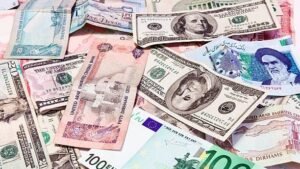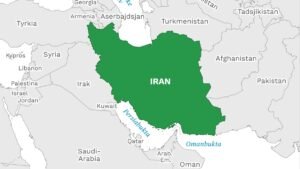Iran’s Currency Reform Plan
|
General Studies Paper II: Impact of foreign countries’ policies and politics on India’s interests |
Why in News?
Iran’s parliament has finally approved a long-debated currency reform plan to remove four zeros from the national currency ‘Rial’. This decision reflects efforts to stabilize the economy, control inflation and rebuild public confidence.
What is Iran’s Currency Reform Plan?
- Iran has officially approved a currency reform plan that has been in discussion for several years and finally received approval from Iran’s parliament in 2025 after addressing the concerns raised by the Guardian Council.
- According to the plan, the government decided to remove four zeros from the rial, converting 10,000 old rials into 1 new rial.
- The restructured currency will continue to be called the rial. However, the new rial will be subdivided into 100 smaller units known as “qerans” (or “gherans”).
- According to the approved legislation, the implementation of the new currency system will begin two years after the approval. This period will allow the Central Bank of Iran (CBI) to prepare all necessary infrastructure, including digital systems, banking procedures, and printing of new notes.
- After this two-year preparation phase, there will be a three-year transition period in which both old and new rials will circulate together.
- The old banknotes will continue to remain valid during this time and will be gradually withdrawn from circulation as the new currency gains acceptance.
Note: Several countries have restructured their currencies to tackle hyperinflation and economic crises.
- Venezuela removed zeros from its bolívar multiple times due to persistent high inflation (2008, 2018, 2021).
- Turkey replaced the old Turkish lira by removing six zeros and introducing a new lira to simplify transactions and improve currency image (2005).
- Brazil eliminated zeros from the cruzeiro after severe inflation in the 1990s to stabilize the economy (1994).
- Zimbabwe faced extreme hyperinflation in the 2000s and repeatedly removed zeros from the Zimbabwe dollar, ultimately turning to foreign currencies for stability (2006–2009).
Reasons Behind Iran’s Currency Reform Decision
- High Inflation: Iran has faced persistent inflation for several years. In May 2025, the inflation rate reached 38.7%, making prices rise rapidly and reducing the purchasing power of citizens.
- Devaluation of the Rial: The rial has lost significant value over decades. Since 1971, it has been devalued nearly 3,500 times, with sharp declines after the 1979 Iranian Revolution and again after 2018, when US sanctions were reimposed.
- Large Numbers in Daily Transactions: The currency’s value dropped so much that 1 US dollar equals around 1,150,000 rials. This forces people to handle extremely large numbers in bills, bank statements, and shopping, complicating everyday financial calculations.
- Reducing Printing Costs: Handling and printing large denomination notes is expensive. By removing four zeros, the government can print smaller notes, reducing logistics and operational costs for the Central Bank.
- Strengthening the Currency: The reform aims to enhance the value of the rial against foreign currencies. Though the impact on international trade may be gradual, it is an effort to improve economic stability and confidence in the currency.
- Simplifying Financial Transactions: The new system will vastly simplify payments and accounting. Shoppers and businesses will no longer need to carry and count huge amounts of rials for everyday purchases, making financial management easier.
Reasons for High Inflation in Iran
-
- Economic Damage After the Iran-Iraq War: The end of the Iran-Iraq War in 1989 left the country’s economy in ruins. It took almost eight years for Iran to rebuild infrastructure and industry. During this period, the rial lost nearly 100% of its value against the US dollar. Rampant inflation and uncontrolled printing of cash worsened the situation and set a long-term pattern of currency instability.
- 1979 Islamic Revolution: Since the 1979 Islamic Revolution, Iran’s economy has faced chronic challenges. Political changes disrupted trade and financial systems. Imports exceeded exports, leading to a persistent trade imbalance. This created a structural weakness where the rial constantly lost value against foreign currencies, fueling inflation over decades.
- Sanctions During Ahmadinejad’s Tenure: In the final years of President Mahmoud Ahmadinejad’s rule (2005–2013), Iran faced severe international sanctions. By 2013, these measures had caused the rial to drop almost 400% in value on global currency markets. The sanctions restricted oil sales, limited banking operations, and cut off access to international financial systems.
- US Withdrawal from Nuclear Deal: The US exit from the 2015 nuclear agreement in 2018 triggered a major economic shock. President Donald Trump’s “maximum pressure” policy imposed additional sanctions targeting oil exports, banking, and shipping. The rial’s value plunged further, leaving it about 600% weaker against the dollar than it had been before the revolution.
- Oil Export Decline: Iran’s main source of revenue, oil exports, fell sharply due to sanctions and reduced global demand. Exports dropped from 1.4–1.7 million barrels per day to approximately 1 million barrels per day by 2025. This decline caused a revenue shortfall of $5–10 billion, limiting government spending capacity and contributing to higher prices domestically.
- Shortage of Foreign Currency: Sanctions on international banking and the SWIFT system restricted Iran’s access to dollars and euros. By 2024, the country’s foreign currency reserves were around $26 billion, and estimates for 2025 suggest $34 billion, but restrictions made it difficult to use these funds effectively.
|
Important Facts about Iran
|
Currency Reforms in India
- India has implemented several currency reforms to stabilize its economy and curb illegal activities.
- India introduced high-denomination currency notes in the past, such as 1000, 5000, and 10,000 rupee notes between 1954 and 1978, which were later withdrawn. These reforms targeted inflation management. The Reserve Bank of India manages all currency issuance and regulation to maintain financial stability.
- On November 8, 2016, Indian Prime Minister Narendra Modi announced that 500 and 1000 rupee notes would no longer be legal tender. Citizens were given a limited time to deposit these notes into banks. The government introduced new 500 and 2000 rupee notes to replace them. This reform aimed to increase transparency and encourage digital payments.
- Recently, the Reserve Bank of India (RBI) launched the Digital Rupee, a central bank digital currency (CBDC), as a major step towards modernizing financial transactions, reducing cash dependence, and promoting financial inclusion.
|
Also Read: US Sanctions on Iranian Oil Network |











